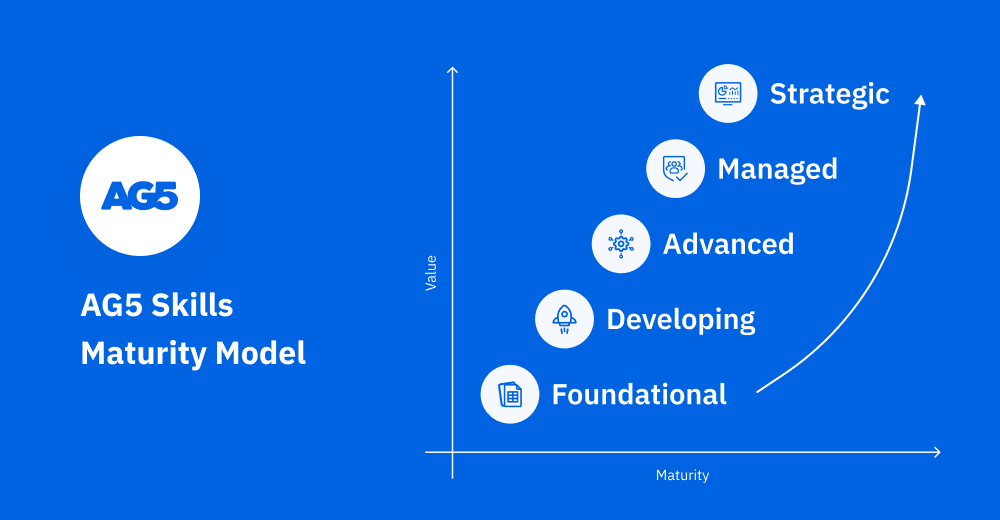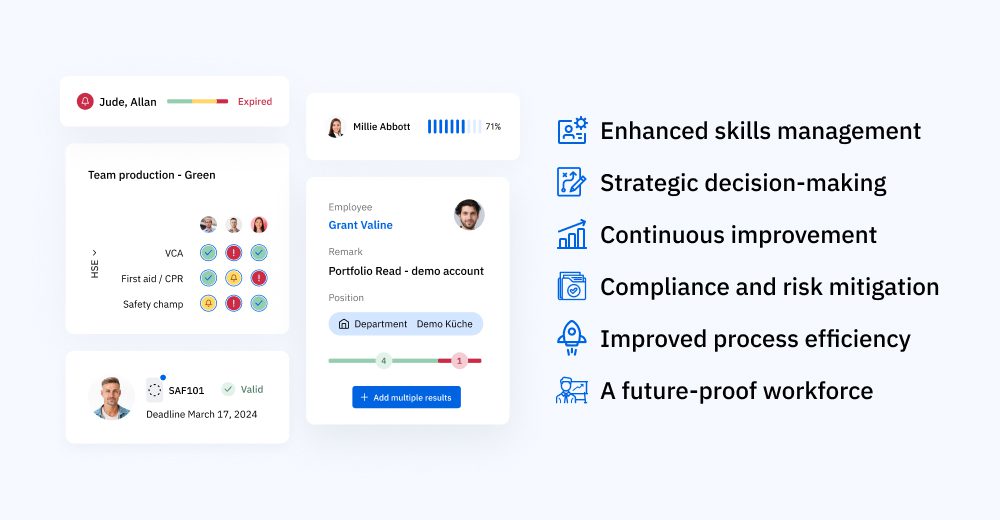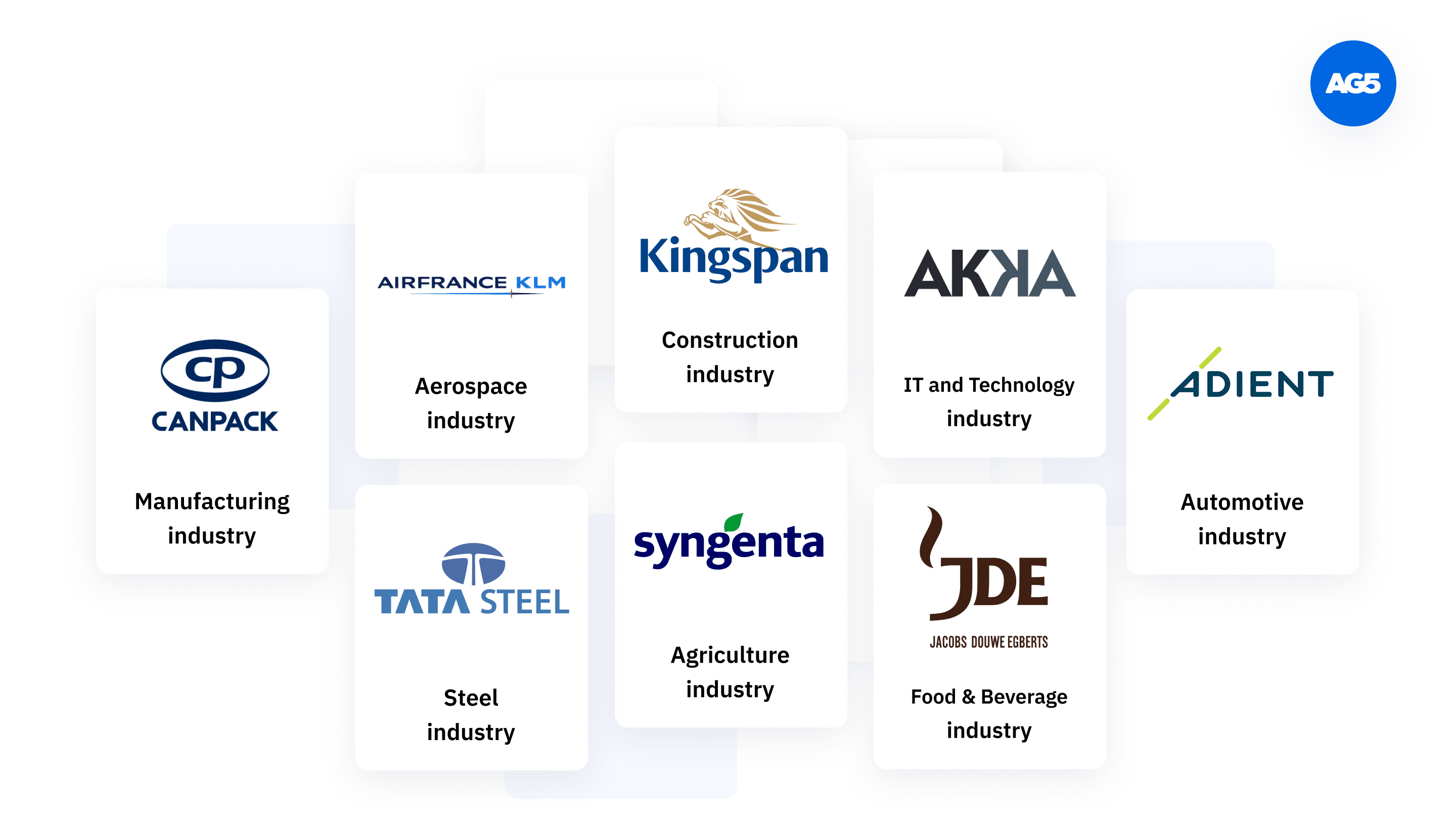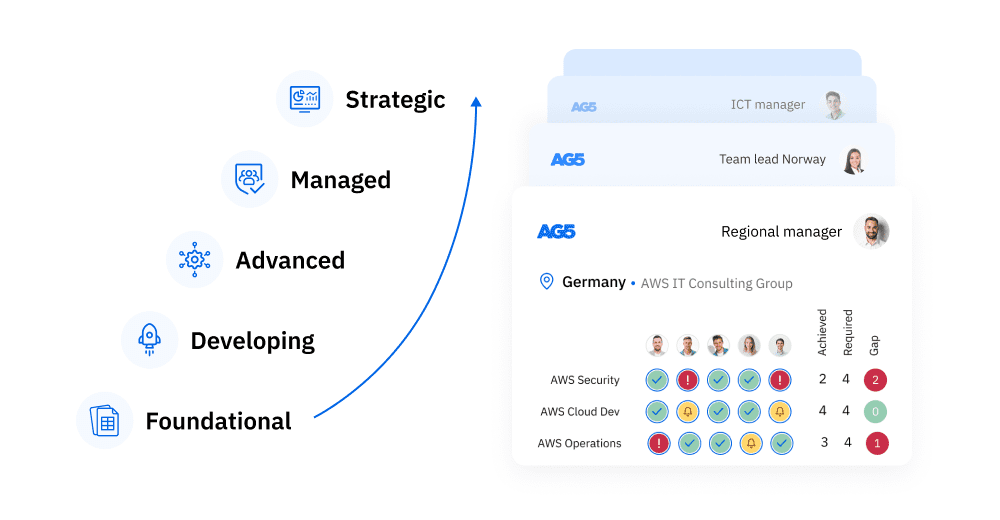How to optimize skills management with the AG5 Skills Maturity Model
In this article we talk about how to elevate your skills management across five progressive levels with the AG5 Skills Maturity Model, which enhances efficiency, compliance, and strategic alignment.

Skills management is a process, hinging upon continuous improvement, self-assessment, and professional development for both organizations and individual employees.
This means that your skills management strategy will require a bit of effort from everyone – starting at the top – to develop a structured approach that works to set you up for long-term skills management success.
But good news – we’ve done a bit of the legwork for you by developing the AG5 Skills Maturity Model!
So what is it, how does it work, and how can you get started using it?
What is the AG5 Skills Maturity Model?Copied
The AG5 Skills Maturity Model guides organizations in assessing and improving their skills management practices on a continuous basis.
It consists of five levels (which we will explore in-depth later), offering a clear progression path from manual processes and inefficiencies to strategic skills management.
As organizations progress through each level of the model, they enhance their skills management capabilities, streamline processes, ensure compliance, and align their workforce with strategic business objectives.
All told, the AG5 Skills Maturity Model empowers organizations to optimize skills management, drive continuous improvement, and achieve workforce excellence.

What are the benefits of using the AG5 Skills Maturity Model?Copied
Organizations that use the AG5 Skills Maturity Model will enjoy a range of benefits. They include:
Enhanced skills management
The AG5 Skills Maturity Model enables organizations to optimize their skills management practices, resulting in more efficient and effective utilization of employee skills.
Improved process efficiency
By progressing through the model’s maturity levels, organizations can identify and streamline inefficient processes, reducing waste and enhancing overall productivity.
Increased data accuracy and visibility
The model facilitates the adoption of standardized skills data management practices, improving the accuracy, consistency, and visibility of skills-related information.
Targeted training and development
With a mature skills management approach, organizations can conduct skills gap analyses and create targeted training plans, ensuring the right skills development opportunities for employees.
Compliance and risk mitigation
By aligning with higher maturity levels, organizations establish robust processes, reducing compliance risks and ensuring adherence to industry standards and regulations.
Strategic decision-making
The AG5 Skills Maturity Model empowers organizations to make informed strategic decisions based on accurate skills data, supporting workforce planning, succession planning, and talent management strategies.
Continuous improvement
By regularly assessing skills management maturity, organizations foster a culture of continuous improvement, driving ongoing enhancements and adaptability to changing business needs.
A future-proof workforce
The model helps organizations build a future-proof workforce with aligned skills, enabling them to stay competitive in evolving markets and leverage emerging opportunities.

Who uses the AG5 Skills Maturity Model?Copied
The following customers leverage the AG5 Skills Maturity Model to optimize day-to-day skills management in their organizations.
Discover skills management for different industries

The five levels of the AG5 Skills Maturity ModelCopied
As mentioned above, the AG5 Skills Maturity Model consists of five levels. Before you start using the model, you will need a thorough understanding of each. Let’s take a look at them:
Foundational level
At the foundational level, organizations operate with manual processes, such as Excel spreadsheets, Word documents, PDFs, and printed forms.
Organizations at the foundational level:
- Work with inefficient processes, skills data inconsistencies, and limited visibility
- Deal with uncertainty and lack of documentation, leading to ad hoc and chaotic approaches to skills management
- Utilize poorly managed and controlled skills management processes and high risk for failure to meet compliance standards
- Take a reactive approach for skills management and audits preparations
The foundational level typically sees organizations experiencing a great deal of pain in skills management, which is why they are seeking an alternative solution. The AG5 skills management journey begins here, aiming to optimize skills management and overcome pain points for an improved skills management process.
Developing level
At the developing level, organizations have transitioned from manual processes to utilizing AG5’s skills management software. They have completely replaced Excel spreadsheets, Word documents, or any other legacy system or manual process with which they previously managed employee skills with.
Organizations on the developing level:
- Have established an audit-proof system
- Leverage a single source of truth for all skills
- Use a structured approach to manage the skills requirements for their entire organization
- Oversee clear and real-time insights into skills gaps, training needs, and compliance .
Developing-level organizations have successfully replaced manual processes with basic skills management in AG5, resulting in a reduction of major pain points. This presents an opportunity for these organizations to align their skills management with processes outside the platform, setting the stage for optimization and advancement to the next level.
Advanced level
At the advanced level, organizations leverage AG5’s full capabilities for skills management. The focus here is on aligning the AG5 skills management system with HR, quality, QHSE, and/or operational processes through automation.
Organizations at the advanced level:
- Automate HR processes in AG5 by integrating their HR system with the software
- Automate training processes by establishing an assignment integration with their LMS system
- Automate AG5’s reporting capability by developing an integration of completed trainings with their LMS system
- Set up communication workflows to avoid the risk not being compliant
- Use AG5 as a central hub for skills management, aligning the organizational requirements defined in AG5 with other goals and systems related to learning management, certification, authorization, compliance, or planning
Advanced-level organizations have achieved process alignment with automation through the entire organization. This means much less manual work is necessary to ensure real-time compliance insights within AG5. Now that the skills management system is aligned with processes the next step is to align the system with the workforce.
Managed level
At the managed level, AG5 becomes an integral tool for ongoing skills management across the organization. Now, the optimization focus turns to the human side of skills management, aligning the workforce with the established skills management system.
Organizations at the managed level:
- Replace inefficient processes of employees’ input with the skills portfolio capabilities of AG5.
- Replace inefficient processes of assessments with the skills assessment capabilities of AG5.
- Align the approval processes with AG5 by using the software’s approval capability
- Enable their managers to manage employee skills efficiently and effectively with automated matrices.
Managed-level organizations enjoy a skills management system that is aligned with both people and processes. Ensuring that a compliant workforce is now a day-to-day task, as everyone is involved in managing their own skills, other skills, or the skills of their employees.
Strategic level
At the strategic level, organizations fully leverage AG5 as an indispensable strategic enabler for skills management. Now that they have aligned processes and people with the skills management system, the focus is placed on strategic alignment.
Organizations at the strategic level:
- Maintain standardized job role, skill, and requirement structures across the organization to promote standardization, clarity and efficiency
- Align global requirements with local requirements to ensure consistency and standardization across the organization
- Manage multilevel requirements to ensure accurate and high-quality requirement data
- Align AG5’s compliance data with financial, performance, and HR analyses to gain comprehensive insights and support data-driven decision-making
- Manage the skills, requirements, and job role master data with AG5’s data management capabilities
- Use skills data to drive strategic decision-making, supporting organizational growth and ensuring a future-proof workforce that meets current and future quality standards
Strategic-level organizations have fully optimized their skills management processes. They have aligned people, processes, and the business strategy while maintaining quality and continuity across the organization.
How do you use the AG5 Skills Maturity Model?Copied
Now that you are familiar with each of the model’s five levels, you can begin to use it. Doing so is a relatively simple – albeit continuous – process, that you can leverage through the following steps:
- Conduct a baseline assessment of your current skills management capability
- Define incremental goals and actions to progress through the Developing, Advanced, Managed, and Strategic Levels
- Regularly evaluate your organization’s skills management maturity, identify areas for improvement, and leverage the model to drive continuous enhancement
Remember, however, that progressing the AG5 Skills Maturity Model does not have to be a fast process. It is important to take your time, ensuring that you have fully completed each level before moving on to the next. This will ensure that your organization is using AG5’s skills management software to its fullest potential.
How does AG5 use the AG5 Skills Maturity Model?Copied
We have integrated the AG5 Skills Maturity Model into the entire customer journey, from initial onboarding to ongoing success management.
During the implementation phase, our dedicated onboarding specialists use the AG5 Skills Maturity Model to highlight the progression from the Foundational Level to the Developing Level, guiding customers in transitioning from manual processes to utilizing AG5 as a central platform for skills management.
Once implemented, our success managers continue to use the model to assess your organization’s current skills management maturity and define milestones for further growth.
This approach has several benefits, as it:
- Ensures a structured and comprehensive approach to skills management, enabling you to continuously improve
- Aligns with your organizational goals to unlock the full potential of AG5
- Empowers you to achieve long-term success by optimizing your skills management capabilities
Download the AG5 Skills Maturity ModelCopied
By downloading the AG5 Skills Maturity Model, you will gain access to an invaluable resource that can guide your organization towards:
- Optimized skills management
- Improved efficiency
- A future-proof workforce
Ready to get started? Take the first step towards unlocking your organization’s skills management potential and download the AG5 Skills Maturity Model.
Download the AG5 Skills Maturity Model
A note on sources
At AG5, we are committed to providing you with high-quality content that is steps above AI-generated lists. As such, we do our best to thoroughly source our articles and guides, ensuring that the information we present to you is for people, by people. Sometimes, however, our content is more product-focused, relying more on our in-house expertise in skills management than external sources. In these cases, there may not be an in-depth source list. However, rest assured that all content goes through an extensive review process before its release.

